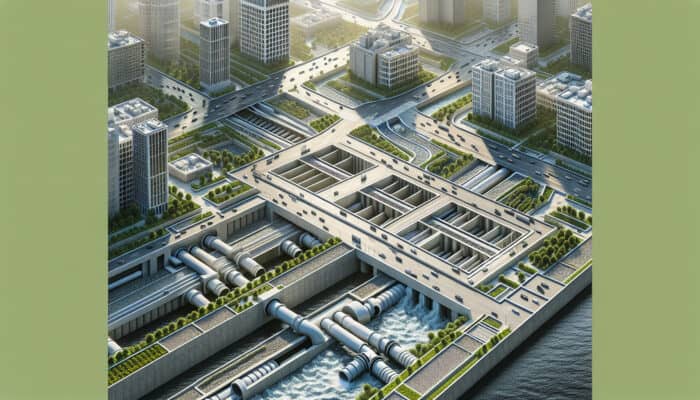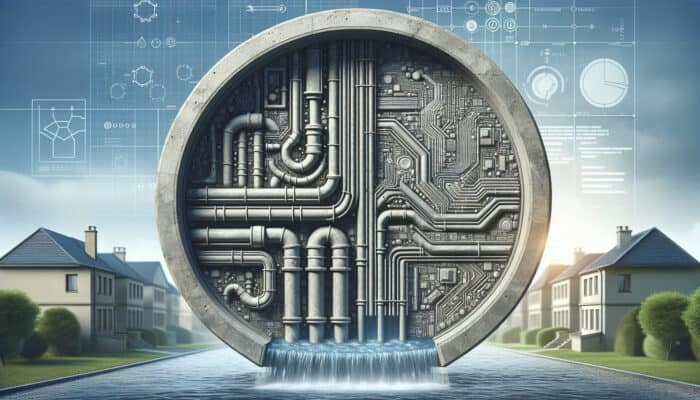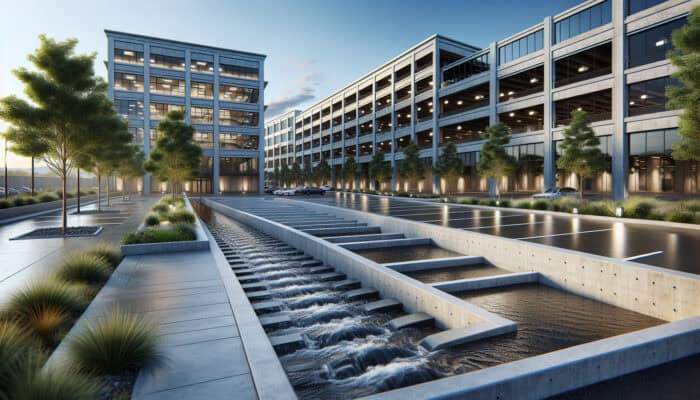Your Comprehensive Guide to Proven Concrete Drainage Solutions
What Key Features Should You Prioritise When Choosing Concrete Drainage Services?

When selecting concrete drainage services, it is essential to consider several crucial aspects, including the installation, maintenance, and repair of drainage systems specifically crafted from concrete materials. These services are vital for adeptly managing water flow, thereby preventing potential water-related damages and preserving the structural integrity of buildings and landscapes. Property owners can explore various options, such as:
- Stormwater drains
- French drains
- Channel drains
- catch basins
- Retaining walls integrated with drainage
- Permeable concrete surfaces
- Concrete ditches
- Slotted drains
By incorporating these specialised systems, property owners can effectively redirect and manage excess water, thereby preventing potential damage while enhancing the longevity and overall value of their investments.
Why Is Proper Drainage Essential for Ensuring Property Safety?
Establishing effective drainage is critical in averting numerous problems that may occur due to stagnant or inefficiently managed water. Insufficient drainage can result in significant complications, such as:
- Water damage to buildings and structures
- Soil erosion that compromises landscaping
- Flooding in vulnerable areas
- Foundation damage leading to costly repairs
- Increased maintenance costs over time
- Environmental degradation affecting local ecosystems
- Health risks linked to stagnant water
- Pest infestations exacerbated by damp conditions
By ensuring that effective drainage systems are correctly installed and maintained, property owners can protect their investments while creating a safe and healthy environment for both residents and visitors alike.
How Are Concrete Drainage Systems Utilised Throughout Langley?
Across Langley, concrete drainage systems are widely implemented across various sectors, addressing residential, commercial, and municipal requirements. In residential zones, homeowners frequently choose French drains to skilfully manage water runoff from their properties. Conversely, larger commercial establishments often rely on stormwater drains to cope with substantial water volumes during intense rainfall events. On a municipal scale, the installation of catch basins in roadways and public parks is essential for efficiently directing surface water away from pathways and vehicular areas, thereby preventing flooding and water accumulation.
What Distinct Benefits Do Concrete Drainage Systems Offer?

Concrete drainage systems present a plethora of advantages, making them a preferred choice among property owners. Their inherent durability guarantees a long service life, significantly reducing the need for frequent repairs. Additionally, these systems are celebrated for their low maintenance requirements, enabling them to endure harsh weather conditions while remaining effective for many years. Furthermore, concrete drainage systems provide exceptional cost efficiency, leading to long-term savings due to their resilience against wear and tear, ultimately establishing them as a prudent investment for effective water management.
Professional Perspectives on Concrete Drainage Solutions Available in Langley
What Critical Factors Should You Evaluate When Choosing Materials?
When selecting materials for concrete drainage systems, experts emphasise the necessity of choosing the right type of concrete that aligns with the specific drainage requirements of a project. Reinforced concrete is often recommended for its superior durability and strength, particularly in areas subjected to heavy traffic or potential soil shifts. For less demanding applications, standard concrete mixes may suffice, providing a balance of cost and performance. Moreover, incorporating permeable concrete allows for natural water infiltration, significantly mitigating runoff and promoting sustainability, which is particularly advantageous in Langley’s climate characterised by frequent rainfall.
What Best Practices Should Be Adhered to for Installing Concrete Drainage Systems?

Following proper installation techniques is crucial for ensuring the long-term effectiveness of concrete drainage systems. Numerous successful installations throughout Langley illustrate how effective grading and drainage slopes are strategically designed to direct water efficiently. A prime example is the successful implementation of a channel drain in a commercial parking lot, which not only optimised water flow but also improved the overall aesthetic appeal of the space. It is vital to ensure that all components of the drainage system are correctly aligned and possess the necessary slope to facilitate smooth water movement.
What Maintenance Strategies Do Professionals Recommend?
Regular maintenance is critical for preserving the longevity and efficiency of concrete drainage systems. Experts recommend several practical steps that property owners can implement, such as:
- Conducting regular inspections of drainage systems to check for debris accumulation
- Clearing any blockages to maintain optimal water flow
- Monitoring for signs of cracking or structural damage
- Cleaning catch basins and grates to prevent sediment build-up
By following these maintenance strategies, property owners can extend the lifespan of their drainage systems while avoiding costly repairs in the future, thus ensuring consistent performance throughout the year.
What Steps Are Involved in the Concrete Drainage Process?
How Does the Water Management Process Function?
Concrete drainage systems operate effectively by channeling water away from structures to prevent damage. The water management process consists of three fundamental components: collection, conveyance, and disposal of water. Collection occurs through features like catch basins, which gather surface water, while conveyance is facilitated by drain pipes that transport water to designated disposal areas such as retention ponds or municipal stormwater management systems. A well-designed system ensures that each component works harmoniously, safeguarding properties from excessive water accumulation.
What Design Elements Are Essential for Maximising Efficiency?
In the design of concrete drainage systems, several critical elements must be taken into account to maximise water flow efficiency. The slope of the drainage system is of utmost importance, as it directly influences the effectiveness of water diversion from structures. Additionally, evaluating the capacity of the system is crucial; it must accommodate expected water volumes, particularly during heavy rainfall events. Material selection also plays a significant role; using high-quality concrete can enhance durability and performance, ensuring that the system retains its efficiency over time.
How Do Concrete Drainage Systems Impact the Environment?
Well-designed concrete drainage systems can substantially reduce environmental impact by effectively managing water runoff. Incorporating features such as bioretention areas assists in filtering pollutants before water is released into local waterways, thus safeguarding ecosystems. Furthermore, utilising permeable materials in designated areas promotes water infiltration into the ground, aiding in the replenishment of groundwater supplies and minimising surface runoff. This consideration is particularly critical in Langley’s diverse natural surroundings, where maintaining water quality is of utmost importance.
What Are the Major Advantages of Concrete Drainage Systems?
Unmatched Durability and Longevity of Concrete Solutions
One of the most significant advantages of concrete drainage systems is their exceptional durability and longevity. Unlike alternative materials that may deteriorate over time, concrete is inherently robust and resistant to extreme weather conditions. Factors contributing to the durability of these systems include the quality of the concrete mix, adherence to proper installation techniques, and consistent maintenance practices. High-quality concrete utilised during construction is less prone to cracking or degradation, ensuring that drainage systems remain functional for an extended duration.
How Are Concrete Drainage Systems Cost-Effective Over Time?
Although the initial investment in concrete drainage systems may exceed that of some alternatives, their long-term cost efficiency is indisputable. Due to their inherent durability, property owners experience fewer repairs and replacements, resulting in significant savings over time. Moreover, reduced maintenance demands translate to lower ongoing costs, making concrete drainage systems a financially sound choice. Ultimately, their ability to function effectively for many years results in lower overall expenses related to property management.
What Makes Concrete Drainage Systems Exceptionally Versatile?
Concrete drainage systems exhibit extraordinary versatility, making them suitable for a wide array of applications. In Langley, these systems can be customised to fit various environments, encompassing residential, commercial, and industrial settings. For example, a permeable pavement system can be effectively employed in parking lots to facilitate natural water infiltration, while channel drains are ideal for directing water away from walkways in public parks. This adaptability ensures that concrete drainage solutions can efficiently meet specific requirements across diverse applications.
What Are the Most Effective Strategies for Concrete Drainage Services in Langley?
What Planning and Design Approaches Yield the Best Results?
Effective planning and design are paramount for the success of concrete drainage systems. Successful projects in Langley often commence with a comprehensive site assessment, which informs the design process. For instance, one commercial project utilised 3D modelling to visualise water flow patterns, enabling the design team to create an efficient drainage solution that minimised flooding risks. Collaborating closely with engineers and landscape architects ensures that all aspects of drainage are considered and integrated into the overall site design, leading to optimal outcomes.
What Installation Techniques Enhance the Performance of Systems?
The optimal performance of concrete drainage systems hinges on precise installation techniques. Key steps involve ensuring proper grading and aligning all components to facilitate smooth water flow. For instance, while installing a French drain, it is crucial to implement an adequate slope to direct water toward the drain while preventing potential blockages. Engaging experienced contractors who possess knowledge of local soil conditions and drainage requirements is essential for achieving lasting results.
How Should Maintenance and Repair Be Managed Efficiently?
Regular maintenance and timely repairs are vital for extending the lifespan of concrete drainage systems. Experts advise establishing an annual inspection schedule, during which property owners can assess the condition of their systems and promptly address any issues. Common maintenance tasks include clearing debris from grates, inspecting for cracks or signs of erosion, and ensuring that all drainage components are functioning as intended. Developing a proactive maintenance plan can help prevent larger, more costly repairs in the future.
What Materials Are Essential for Concrete Drainage Systems?
Which Types of Concrete Are Most Frequently Utilised?
A variety of concrete types are employed in drainage systems, each possessing distinct properties and applications. Reinforced concrete, for example, is preferred for its strength and durability, making it suitable for high-load applications such as roadways. Conversely, lightweight concrete may be used in less demanding situations where weight considerations are crucial. Additionally, permeable concrete is gaining traction due to its ability to allow water passage, thus reducing surface runoff and promoting sustainable drainage design.
What Reinforcement Materials Enhance the Strength of Systems?
To bolster the strength and durability of concrete drainage systems, reinforcement materials such as rebar and wire mesh are often utilised. These materials provide additional structural integrity, enabling the systems to withstand the pressures imposed by soil and water loads. The inclusion of reinforcement materials is especially beneficial in areas exposed to heavy traffic or shifting soil, where concrete systems may otherwise be susceptible to cracking or failure. Their use guarantees that drainage systems maintain their functionality over time.
How Do Surface Treatments and Coatings Protect Systems?
Surface treatments and coatings are essential in safeguarding concrete drainage systems from wear and corrosion. These treatments can encompass sealants that prevent water infiltration, as well as anti-slip coatings that enhance safety in public areas. Additionally, applying anti-corrosive materials can prolong the lifespan of systems exposed to harsh environmental conditions, such as de-icing agents during winter months. By investing in these protective measures, property owners can significantly enhance the durability and performance of their drainage systems.
What Common Challenges Do Concrete Drainage Systems Face?
How Can Clogging and Blockage Issues Be Effectively Resolved?
Clogging and blockage are prevalent challenges that can severely compromise the effectiveness of concrete drainage systems. Signs of clogging may include water pooling around drainage areas or slow drainage rates during rainfall events. Common contributing factors include debris accumulation, sediment build-up, or root intrusion from surrounding vegetation. Conducting regular inspections and maintenance can help identify potential blockages early, ensuring that drainage systems operate efficiently and effectively without disruption.
What Factors Lead to Cracking and Structural Damage?
Cracking and structural damage pose significant threats to the integrity of concrete drainage systems if not remedied promptly. Factors that contribute to these issues encompass rapid temperature fluctuations, improper installation practices, and soil movements. Regular monitoring of the system can assist in detecting early signs of stress, allowing property owners to take corrective action before the damage escalates. Utilising high-quality materials during installation can also mitigate the likelihood of future cracking and structural failures.
What Are the Effects of Erosion and Sediment Accumulation?
Over time, erosion and sediment accumulation can greatly influence the performance of concrete drainage systems. Erosion may occur as a result of heavy rainfall or ineffective water management, leading to soil loss around drainage components. Concurrently, sediment build-up can obstruct water flow, causing backups and potential flooding. Implementing effective landscaping and maintenance practices can help avert these issues, thereby ensuring that drainage systems remain functional and efficient over the long term.
How Do Corrosion and Material Degradation Impact Drainage Systems?
Corrosion and material degradation can jeopardise the integrity of concrete drainage systems, potentially resulting in expensive repairs. Factors influencing corrosion encompass exposure to harsh chemicals, water quality, and environmental conditions. Conducting regular inspections can help pinpoint areas susceptible to corrosion, allowing for timely interventions to safeguard the system. Incorporating protective coatings and selecting corrosion-resistant materials during installation can significantly bolster resilience against degradation, thereby extending the lifespan of drainage systems.
What Are the Consequences of Improper Installation and Design Flaws?
Improper installation and design flaws are significant contributors to drainage system failures. Common installation errors may include inadequate grading, incorrect material selection, or overlooking local soil conditions. Such oversights can lead to persistent flooding or inefficiencies within the drainage system. Engaging skilled contractors who are familiar with local regulations and best practices is essential to ensure that drainage systems are correctly installed and function as intended.
How to Select the Right Concrete Drainage Service Provider?
What Key Considerations Should Guide Your Selection Process?
Choosing the right service provider for concrete drainage projects is vital for achieving successful outcomes. Key factors to evaluate include the provider’s experience, expertise, and reputation within the local market. Additionally, confirm that the provider holds the necessary licenses and insurance, ensuring compliance with legal standards and protection against potential liabilities. Understanding the provider’s approach to project management and customer service will further assist in making an informed decision.
What Questions Should You Ask Potential Providers?
When interviewing potential concrete drainage service providers, posing relevant questions can help ensure that you select a qualified and trustworthy team. Important questions to consider include:
- What is your experience with concrete drainage systems?
- Can you provide references from previous clients?
- What materials do you recommend for my specific project?
- How do you handle unexpected issues during installation?
- What is your warranty policy on completed work?
These inquiries will furnish valuable insights into the provider’s capabilities and reliability, aiding your decision-making process.
How to Evaluate Past Projects and Client References?
Assessing past projects and client references is an effective method for gauging a provider’s experience and quality of work. Reviewing case studies and examples of similar drainage projects can highlight the provider’s strengths and weaknesses. Direct engagement with past clients can also provide insights into their satisfaction levels and the provider’s ability to meet deadlines and budget constraints. This thorough evaluation cultivates confidence in selecting a competent service provider.
Why Is It Important to Verify Licensing and Insurance?
Verifying a service provider’s licensing and insurance is crucial for ensuring they meet legal requirements and can effectively manage potential liabilities. A licensed contractor demonstrates adherence to local regulations, while appropriate insurance safeguards both the provider and the property owner in the event of accidents or damage during the project. Requesting documentation and validating its authenticity can help prevent complications in the future.
How to Effectively Compare Quotes and Service Agreements?
Acquiring and comparing detailed quotes and service agreements from multiple providers is a vital step in selecting a concrete drainage service. Pay close attention to the scope of work, materials employed, and warranty terms outlined in each proposal. This comparison will guarantee you receive the best value and fully understand the terms of service. Clear communication with all potential providers will facilitate a smoother project execution.
What Emerging Trends Are Shaping the Future of Concrete Drainage Services?
How Are Technological Innovations Transforming the Industry?
Technological advancements are driving innovative changes in concrete drainage systems, enhancing their efficiency and sustainability. For example, the integration of drainage monitoring systems enables real-time assessments of water flow and potential blockages. Smart technologies can also deliver data analytics to optimise drainage performance, ensuring that properties can adapt more effectively to climate variations and water management challenges.
Why Are Sustainable Practices Gaining Significance?
Sustainable practices are becoming increasingly crucial in the design and implementation of concrete drainage systems. Incorporating elements such as rain gardens and green roofs not only helps manage runoff but also promotes biodiversity. Utilising recycled materials in concrete production supports sustainability initiatives. These innovative practices not only address pressing environmental issues but also align with the growing demand for eco-friendly construction solutions in Langley.
What Effects Do Regulatory Changes Have on the Concrete Drainage Industry?
Regulatory changes can significantly impact the design and installation of concrete drainage systems, necessitating adherence to new standards. Local municipalities may introduce stricter environmental regulations aimed at enhancing water quality and minimising runoff. Staying informed about these changes is essential for both service providers and property owners, ensuring that all drainage systems comply with current legal requirements and best practices.
What New Materials and Designs Are Influencing the Future?
The future of concrete drainage services is being shaped by the emergence of new materials and innovative designs. Research into high-performance concrete and alternative materials like geopolymer concrete is paving the way for more durable and sustainable drainage solutions. These advancements improve the performance and resilience of concrete systems, addressing challenges posed by shifting environmental conditions while ensuring efficiency in managing water runoff.
Frequently Asked Questions About Concrete Drainage Services
What Are the Main Types of Concrete Drainage Systems?
The primary types include stormwater drains, French drains, channel drains, catch basins, and permeable concrete surfaces, each tailored for specific applications in effective water management.
How Can I Tell If My Drainage System Is Clogged?
Indicators of clogging include pooling water around drainage areas, slow drainage rates, and visible debris within catch basins. Conducting regular inspections can help uncover these issues early.
Which Materials Are Best Suited for Concrete Drainage Systems?
Optimal materials encompass reinforced concrete for its durability, permeable concrete for sustainable water management, and high-quality surface treatments to resist wear and prolong system lifespan.
How Frequently Should I Perform Maintenance on My Concrete Drainage System?
Routine maintenance should ideally be conducted at least once a year, with more frequent inspections recommended following heavy storms or significant weather events.
Is It Possible to Install a Concrete Drainage System Myself?
While DIY installation is feasible, hiring professionals is advisable to ensure compliance with local codes and optimal system performance.
What Are the Long-Term Costs Associated with Concrete Drainage Systems?
Long-term costs are generally reduced due to lower maintenance requirements and high durability, ensuring fewer repairs and replacements over time.
What Criteria Should Influence My Choice of Concrete Drainage Service Provider?
Consider criteria such as experience, licensing, insurance, past project references, and the quality of their service agreements and quotes.
Are There Environmentally Friendly Options for Concrete Drainage Systems?
Indeed, environmentally friendly options exist, including the use of permeable concrete, integrating rain gardens, and recycling materials during the construction of drainage systems.
What Common Issues Do Concrete Drainage Systems Encounter?
Common challenges include clogging, cracking, erosion, corrosion, and improper installation, all of which can undermine the system’s effectiveness.
What Steps Should I Take If My Drainage System Is Damaged?
If damage is detected, consult with a professional drainage service provider to assess the extent of the damage and recommend appropriate repair methods.
Connect with us on Facebook!
The Article: Concrete Drainage Services in Langley: Expert Solutions First Published On: https://pacificbluemechanical.ca/
The Article Concrete Drainage Services: Expert Solutions in Langley Was Found On https://limitsofstrategy.com

